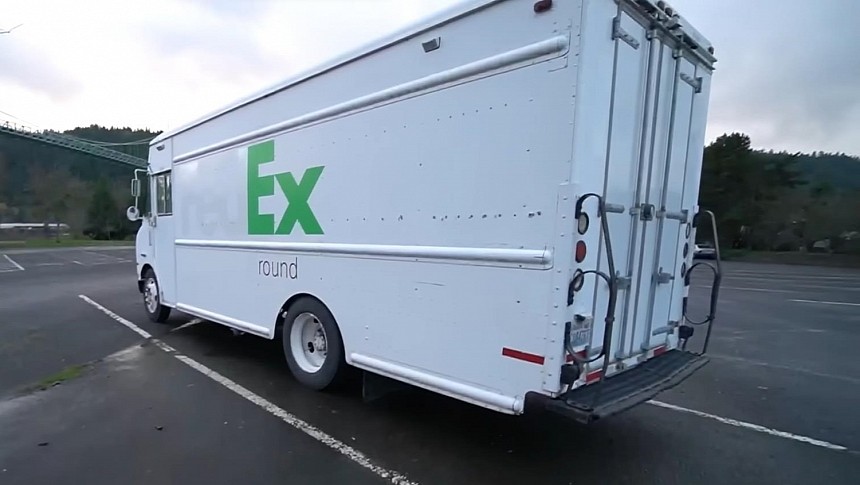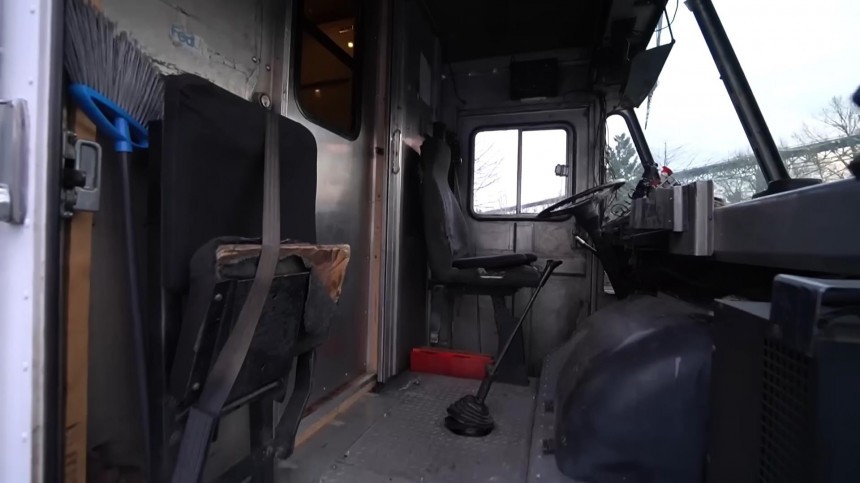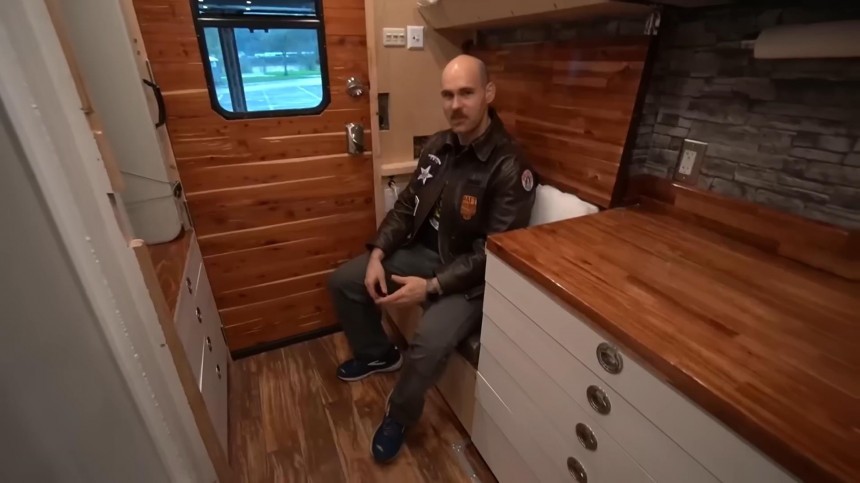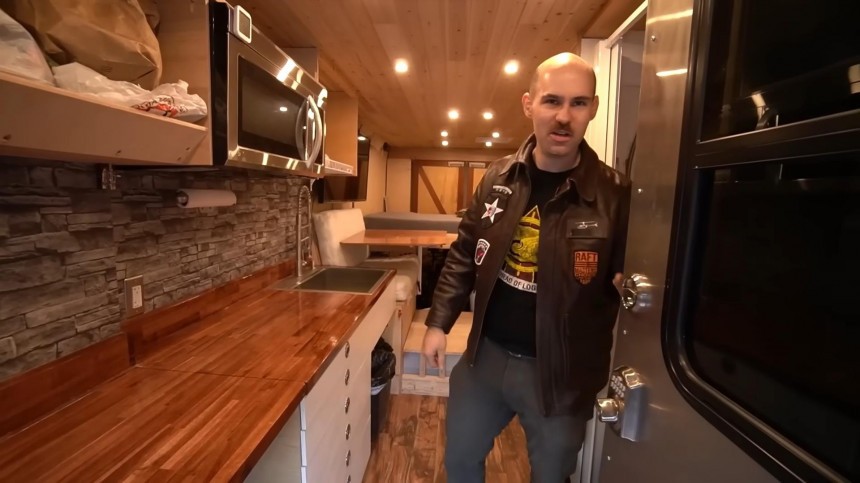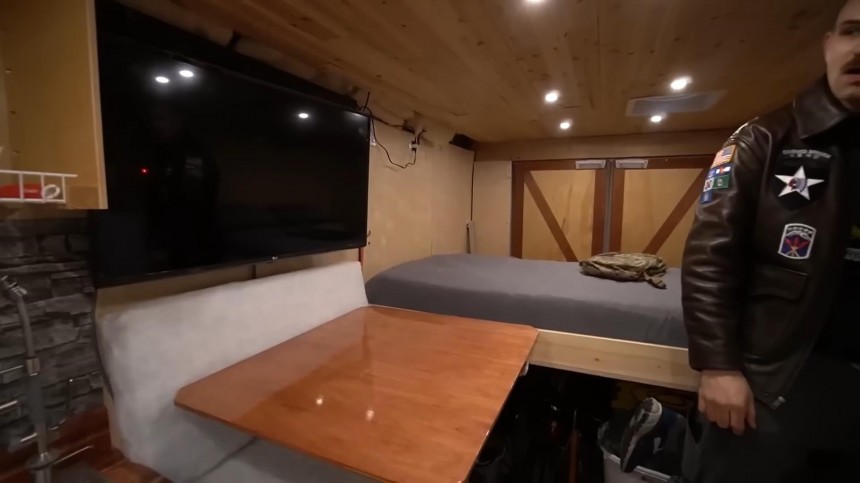While some people make it obvious that their vehicles are campers, others want to keep things low-key for reasons I will detail below. I've already covered several stealthy builds on autoevolution, but today is the first time I'll discuss a tiny home made out of a FedEx truck.
But first, why would somebody make their tiny home on wheels inconspicuous? In my opinion, there are two main reasons. One is that it makes it easy to camp almost anywhere, even in places where a camper van wouldn't be typically allowed, such as in many urban areas. That also means you can save money by paying for a night at an RV park or a campground.
Another reason is safety – thieves can target mobile homes, but if you use a stealthy camper, you drastically decrease the chances of any ill-intended people breaking into your home.
Of course, there are some disadvantages to having a stealthy home. First, if you want to go genuinely incognito, you shouldn't have any windows on the side of your rig, meaning you'll get less light inside. Moreover, the very useful solar panels can give your camper away, as well as other features such as bike racks.
Many stealth campers are based on vans, but an even better option would be a box truck. Of course, there are other suitable base vehicles, such as the FedEx step van I'll be covering today. Compared to box trucks, step vans are easy to work on and have a sturdy construction. Step vans have a conventional cab, with the engine in front, while box trucks have the engine below the driver's seat.
John is the owner and builder of this tiny home based on a 1998 GMC Grumman Olson step van with a 178" wheelbase. On the outside, there's no indicator of this vehicle's camper DNA – it even has part of the brand's sticker still attached, just the "Ex." It's equipped with a 60-gallon (227-liter) diesel tank and a manual transmission. The vehicle is 27 feet (8.2 meters) long bumper-to-bumper, while the cargo area measures 18 feet (5.5 meters).
Let's start with the driver's cabin. As I mentioned earlier, this part is separated from the rig's living space. Open the sliding door, and you'll discover a fold-up seat, but besides a porch light above, the driver's cabin is pretty much as it was originally designed.
To get inside, you'll have to unlock a very sturdy sliding metal door and then unlock an additional door with a keypad lock. Even though the outside and the driver's cabin look precisely as you'd expect on an old FedEx truck, things significantly change once you open this second door.
The first part of the living space is the kitchen. You'll find a 12 V fridge/freezer on your left with some drawers underneath. On the opposite side, John installed a bench seat with a 30-gallon (114-liter) freshwater tank underneath with a flip-up countertop above.
By the way, there are two more 30-gallon freshwater tanks integrated into this camper, as well as a 30-gallon grey water tank for the sink and a 15-gallon (57-liter) one for the shower. Except for this latter one, all are actually inside the camper for easy fixes and to prevent freezing.
While we're on the topic of utilities, John fitted an Espar S2 diesel heater with a thermostat. What's more, there are 400 W solar panels on the roof. Since no windows are inside, John added two ceiling fans for proper ventilation.
To preserve the temperature inside, he added two inches (five centimeters) of wool insulation on the floor and 3.5 inches (9 centimeters) on the ceiling.
There's a bunch of counter space available in the next part of the kitchen, a huge overhead microwave, a massive sink, a drying rack, and many storage spaces in the form of cabinets and drawers. What's more, you'll notice the stone backsplash, which is, in fact, a simple $10 wallpaper off Amazon. Opposite the sink, John fitted two huge drawers and a large pull-out pantry, as well as what John calls a "t-shirt pantry."
Next to the fridge, John devised a spacious shower with a 32 x 32-inch (81 x 81-centimeter) fiberglass shell. One very nice and useful touch is a foldable drying rack near the ceiling John got from Home Depot. In fact, most of what you see inside this rig is from Home Depot, meaning he hasn't spent a fortune on all the features.
Next, we have the seating area located close to the middle of the interior. It's quite simple, consisting of two benches and a lagoon table. Other notable elements are a 40-inch, 4k TV with surround sound and a subwoofer underneath the other bench, as well as a PS4. Moreover, the area can be turned into an extra bed, which can fit two people.
Behind the wall on the driver's side of the rig, Josh hid the electrical system and devised a "control center" on a wood panel.
This control center is quite complex. First, you'll notice three small lights, which indicate whether the water heater, headlights, or the radio are turned on. There are also switches for both the interior and exterior lights and a switch that can select either the water heater or the engine block heater (which warms up the diesel engine in the cold) because they both run on 1,200 W. There's also a timer that lets you select how long to run either of the heaters.
And lastly, we have the bedroom, featuring a queen-size frame but only a twin-size mattress mounted from side to side. What I love about John's setup is that the bed can be lifted to reveal a massive garage, where he stores two bikes, a hot water tank, and various other stuff. Furthermore, if you open the rear door, you can extend an in-built drawer slide outside.
Considering he got most of the stuff inside from Home Depot and built the rig himself, it's safe to assume this was quite a cheap project. Luckily, we don't have to assume, as John shared the exact price: he paid a little more than $3,500 (€3,202) for the base vehicle, and the conversion cost a really fair $21,500 (€19,669), bringing the total price to $25,000 (€22,870).
Considering the cozy and well-equipped living space, this is an excellent deal. Of course, because this was John's first project and he had other responsibilities, it took him 18 months to build the rig. What's more, he spent an astonishing four years planning the project, watching hundreds of videos to learn how to build it and to figure out his ideal layout (just like you're probably doing now).
Still, it's a unique and impressive rig, and its stealthiness makes it even more suitable for a full-time home.
Another reason is safety – thieves can target mobile homes, but if you use a stealthy camper, you drastically decrease the chances of any ill-intended people breaking into your home.
Of course, there are some disadvantages to having a stealthy home. First, if you want to go genuinely incognito, you shouldn't have any windows on the side of your rig, meaning you'll get less light inside. Moreover, the very useful solar panels can give your camper away, as well as other features such as bike racks.
Many stealth campers are based on vans, but an even better option would be a box truck. Of course, there are other suitable base vehicles, such as the FedEx step van I'll be covering today. Compared to box trucks, step vans are easy to work on and have a sturdy construction. Step vans have a conventional cab, with the engine in front, while box trucks have the engine below the driver's seat.
Let's start with the driver's cabin. As I mentioned earlier, this part is separated from the rig's living space. Open the sliding door, and you'll discover a fold-up seat, but besides a porch light above, the driver's cabin is pretty much as it was originally designed.
To get inside, you'll have to unlock a very sturdy sliding metal door and then unlock an additional door with a keypad lock. Even though the outside and the driver's cabin look precisely as you'd expect on an old FedEx truck, things significantly change once you open this second door.
The first part of the living space is the kitchen. You'll find a 12 V fridge/freezer on your left with some drawers underneath. On the opposite side, John installed a bench seat with a 30-gallon (114-liter) freshwater tank underneath with a flip-up countertop above.
While we're on the topic of utilities, John fitted an Espar S2 diesel heater with a thermostat. What's more, there are 400 W solar panels on the roof. Since no windows are inside, John added two ceiling fans for proper ventilation.
To preserve the temperature inside, he added two inches (five centimeters) of wool insulation on the floor and 3.5 inches (9 centimeters) on the ceiling.
There's a bunch of counter space available in the next part of the kitchen, a huge overhead microwave, a massive sink, a drying rack, and many storage spaces in the form of cabinets and drawers. What's more, you'll notice the stone backsplash, which is, in fact, a simple $10 wallpaper off Amazon. Opposite the sink, John fitted two huge drawers and a large pull-out pantry, as well as what John calls a "t-shirt pantry."
Next, we have the seating area located close to the middle of the interior. It's quite simple, consisting of two benches and a lagoon table. Other notable elements are a 40-inch, 4k TV with surround sound and a subwoofer underneath the other bench, as well as a PS4. Moreover, the area can be turned into an extra bed, which can fit two people.
Behind the wall on the driver's side of the rig, Josh hid the electrical system and devised a "control center" on a wood panel.
This control center is quite complex. First, you'll notice three small lights, which indicate whether the water heater, headlights, or the radio are turned on. There are also switches for both the interior and exterior lights and a switch that can select either the water heater or the engine block heater (which warms up the diesel engine in the cold) because they both run on 1,200 W. There's also a timer that lets you select how long to run either of the heaters.
Considering he got most of the stuff inside from Home Depot and built the rig himself, it's safe to assume this was quite a cheap project. Luckily, we don't have to assume, as John shared the exact price: he paid a little more than $3,500 (€3,202) for the base vehicle, and the conversion cost a really fair $21,500 (€19,669), bringing the total price to $25,000 (€22,870).
Considering the cozy and well-equipped living space, this is an excellent deal. Of course, because this was John's first project and he had other responsibilities, it took him 18 months to build the rig. What's more, he spent an astonishing four years planning the project, watching hundreds of videos to learn how to build it and to figure out his ideal layout (just like you're probably doing now).
Still, it's a unique and impressive rig, and its stealthiness makes it even more suitable for a full-time home.
